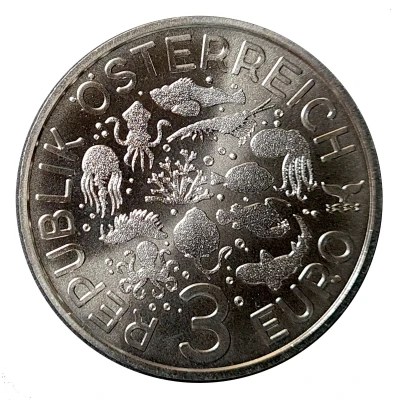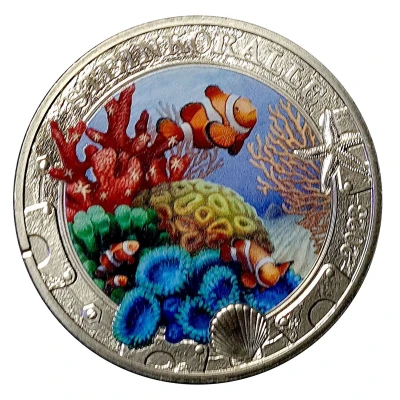


3 Euros Stony Coral
2023 year| Copper-nickel | 16 g | 34 mm |
| Issuer | Austria |
|---|---|
| Period | Second Republic (1945-date) |
| Type | Non-circulating coin |
| Year | 2023 |
| Value | 3 Euros 3 EUR = USD 3.31 |
| Currency | Euro (2002-date) |
| Composition | Copper-nickel |
| Weight | 16 g |
| Diameter | 34 mm |
| Shape | Round |
| Technique | Milled, Coloured |
| Orientation | Medal alignment ↑↑ |
| Updated | 2024-10-04 |
| Numista | N#388203 |
|---|---|
| Rarity index | 57% |
Reverse
Stony coral.
Script: Latin
Lettering:
STEINKORALLE
2023
Designers: Kathrin Kuntner, Rebecca Wilding
Edge
Reeded
Comment
Stony Coral, the fifth 3-euro coin in the Luminous Marine Life series, transports you right into the most species-rich of marine habitats – the coral reef. This is because stony corals use themselves as material to build fantastic living worlds where other sea creatures also thrive, including the clownfish, with its bright orange body and three black-edged white stripes.
Hermatypic or reef-building corals can have the most diverse growth forms. Most stony coral species excrete calcium carbonate at their base and a calcareous skeleton is formed through a symbiosis with zooxanthellae, unicellular microalgae. They reproduce by forming new coral calyxes on top of old ones or when coral polyps become independent. If undisturbed they will continue doing so as long as the seawater remains clean and there is enough sunlight.
Some species of stony coral can live for several hundred years, which may explain why at certain points in the history of Earth, stony coral formed entire islands and archipelagos over thousands of years, such as the Bahamas, Bermuda and the Maldives. Moreover, about 600,000 years ago, corals began to build the Great Barrier Reef off the coast of Australia. Today, with its 359 species of stony coral, the reef is the largest structure created by living creatures on earth and provides habitat for a multitude of other species.
That said, worldwide coral mortality has been linked to increased surface water temperatures caused by global heating. Severe ‘coral bleaching’ occurred in 1998 after an occurrence of the El Niño phenomenon in the western Pacific and Indian Oceans when temperatures were 1 to 3°C above the long-term average for months. To ensure that the ocean habitat remains as diverse and colourful as on the Luminous Marine Life coins, it is thus imperative that we protect it, not least from ourselves.